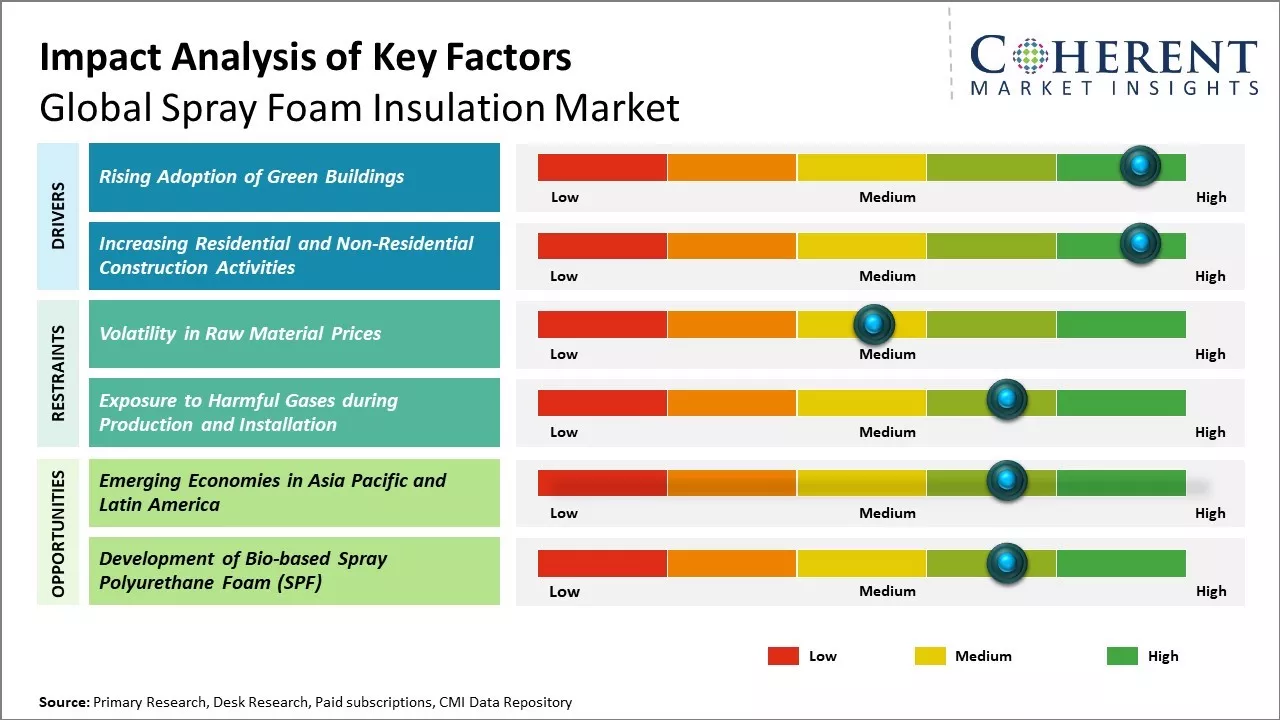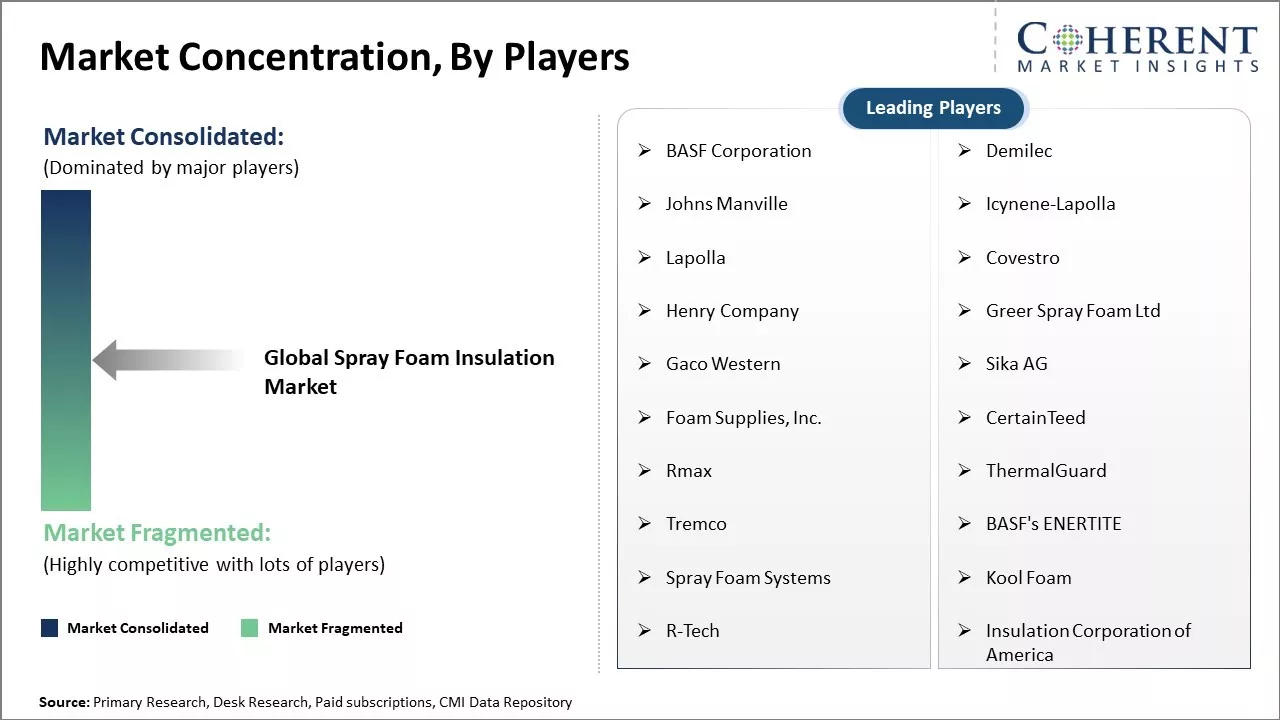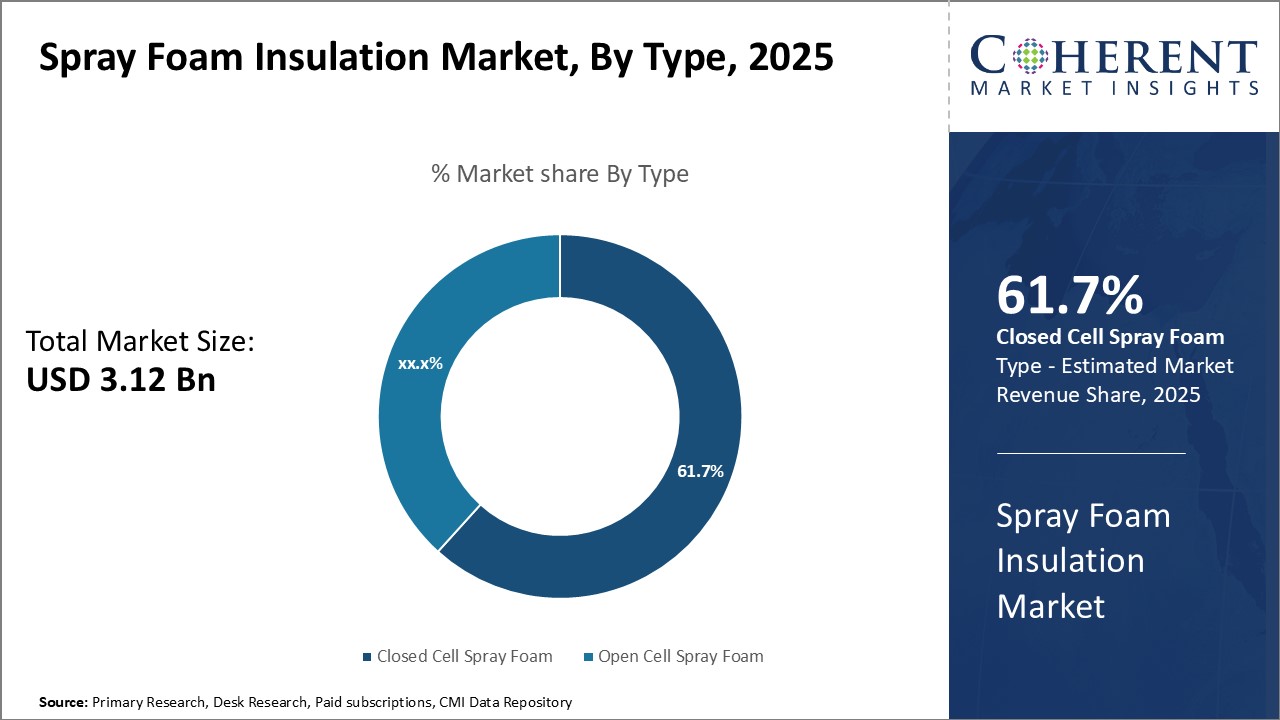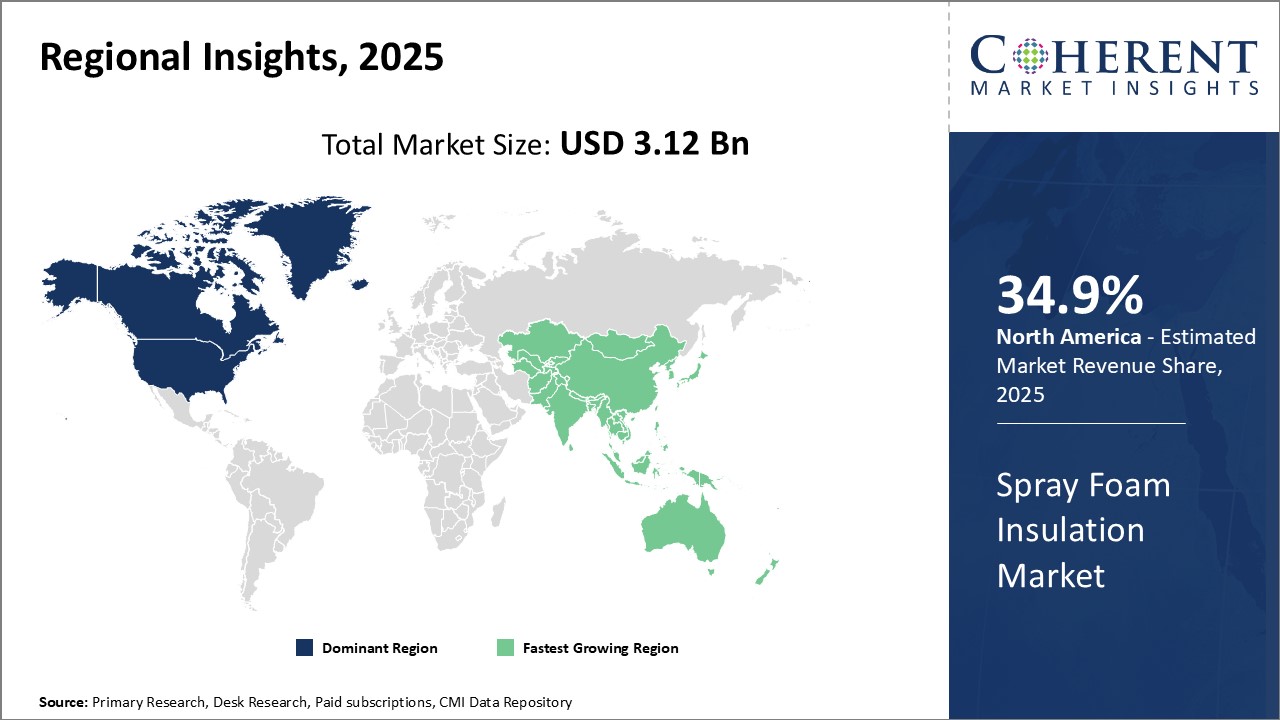Spray Foam Insulation Market Size and Trends
Global spray foam insulation market is estimated to be valued at USD 3.12 Bn in 2025 and is expected to reach USD 4.39 Bn by 2032, exhibiting a compound annual growth rate (CAGR) of 5.0% from 2025 to 2032.

Discover market dynamics shaping the industry: Download Free Sample
Market Driver - Rising adoption of green buildings
With growing environmental consciousness, green building practices are becoming increasingly popular globally. Spray foam insulation plays a vital role in green building methods due to its superb insulating and air sealing capabilities. It helps qualify buildings for green certifications by achieving high R-value levels that lower heating and cooling requirements significantly. Spray foam can insulate areas that other materials struggle with like attics, crawl spaces, rim/band joists. This results in an ultra-tight building envelope that lowers a building's carbon footprint over its lifespan by reducing energy consumption.
Regulations in various countries now mandate certain energy efficiency standards for new constructions. This encourages more builders and developers to adopt sustainable designs and materials like spray foam insulation. Government incentives also propel the green building movement. In the U.S., buildings that achieve the Leadership in Energy and Environmental Design (LEED) certification or comply with ENERGY STAR labels, a voluntary program established by the U.S. Environmental Protection Agency (EPA) receive tax benefits. Homeowners can qualify for rebates on ENERGY STAR certified houses. Such regulatory pushes and financial rewards can boost adoption of spray foam insulation.
Sustainability Drives Building Decisions for Institutions and Corporations. These want to portray their green credentials and reduce operating expenses. Spray foam meets their insulation needs while allowing them to flaunt green building certifications. The product is hence finding more takers for institutional buildings like hospitals, schools, offices that seek to lower their carbon footprint. With sustainability emerging as a mainstream priority, there will be huge demand from green institutional constructions.
Market Concentration and Competitive Landscape

Get actionable strategies to beat competition: Download Free Sample
Increasing residential and non-residential construction activities
Rising construction industry across major world economies can boost demand for spray foam insulation. On the residential front, rising global population leads to increase in housing needs. Various nations such as India and others are witnessing gigantic residential building schemes to address the accommodation requirements. The spray foam insulation market is stimulated by these large-scale housing and apartment construction projects.
Infrastructural expansion is concurrently happening to upgrade national infrastructure. Redevelopment of commercial districts and buildings, malls, shopping centers requires vast amounts of spray foam for insulation. The transport infrastructure aircrafts, ships, vehicles demand spray foams for their lightweight insulating properties. These diverse non-residential construction activities ranging from public infrastructure to private industrial constructions create relentless requirements for spray foam insulation.
Emerging markets especially in Asia Pacific and Latin America witness rapid urbanization, which leads to residential constructions. With growth in household incomes, middle-income populations are spending more on home improvement projects and green housing. This boosts the usage of spray foam for insulation in renovation and remodeling activities. Government investments directed towards infrastructure modernization boosts spray foam consumption. Gigantic construction industry trends in developing regions can drive the global spray foam insulation market growth.
Key Takeaways from Analyst:
Global spray foam insulation market growth is driven by rising sustainability concerns and stringent energy efficiency regulations worldwide. Many countries offer incentives and subsidies to encourage the use of spray foam for insulating both residential and commercial buildings. Growing construction activities in developing nations such as India and China and other can boost demand for spray foam insulation. Spray foam provides excellent insulation and air sealing, thus, helping to reduce heating and cooling costs significantly. It can cover irregular surfaces completely which makes it an excellent choice for attics, basements and other hard-to-reach areas.
North America currently dominates the market due to strict energy efficiency norms. However, Asia Pacific region is expected to be the fastest growing region due to rising disposable incomes, rapid urbanization and favorable government policies promoting green buildings in countries like China and India.
North America expands at a steady pace due to rising renovation and retrofit activities. High upfront costs of spray foam machines can hamper the market growth. Payback period is relatively short due to the resulting energy cost savings over the lifespan of the building. Ongoing technological advancements aim to develop more sustainable spray foam formulations.
Market Challenge - Volatility in raw material prices
Global spray foam insulation market growth can be hampered due to volatility in raw material prices. Spray foam insulation heavily relies upon petroleum-based raw materials like polyols and isocyanates for their manufacturing. These raw materials are derived from crude oil and natural gas. Over the past few years, price of crude oil has witnessed high fluctuations depending upon global demand-supply dynamics and geopolitical issues. Any increase in crude oil prices directly impacts the prices of spray foam insulation since polyols and isocyanates account for more than 50% of the total manufacturing cost. This volatility in key raw material prices poses serious pricing challenges for spray foam insulation manufacturers. It becomes difficult for them to offer stable long term pricing to their customers. Frequent changes in insulation quotes provided by suppliers can disrupt ongoing construction projects. It can also negatively affect buyer's confidence in spray foam insulation market.
Market Opportunity - Emerging economies in Asia Pacific and Latin America
Global spray foam insulation market witness huge opportunities from emerging economies of Asia Pacific and Latin America. Both these regions are witnessing rapid urbanization and infrastructure development activities. Countries like India, Indonesia, Brazil, Mexico, and others are increasingly investing in commercial and residential construction projects. Their growing middle-class population boosts demand for better quality housing units with improved energy efficiency. Spray foam insulation, due to its lightweight and easy installation advantages, is very well suited for these dynamic construction markets. Its ability to seal cracks and gaps effectively makes it a suitable choice for reducing cooling and heating bills. If marketed and positioned correctly, spray foam insulation has strong growth prospects in Asia Pacific and Latin America region over the next decade. Manufacturers should focus on establishing local production facilities and distribution networks to tap into this lucrative market opportunity.

Discover high revenue pocket segments and roadmap to it: Download Free Sample
Insights, By Type: Versatility and cost-effectiveness
In terms of type, closed cell spray foam segment is estimated to contribute the highest market share of 61.7% in 2025. Open cell spray foam insulation is a versatile material that can be used in both residential and commercial construction applications. Its open cell structure makes it flexible enough to conform to any shape or cavity, which allows it to easily insulate irregular spaces that closed cell foams cannot reach. This conformability means less material is wasted during the installation process.
Insights, By Application: Growth in green building standards and DIY projects
In terms of application, residential segment is estimated to contribute the highest market share of 41% in 2025. Majority of spray foam insulation is used in residential construction rather than commercial or industrial settings due to rising demand to improve the energy efficiency of homes. In many countries and regions, building codes and standards are becoming stricter in mandating high insulation levels and airtight construction practices in residential buildings.
Spray foam excellently meets green building standards through superior air sealing and thermally insulating properties. Its ease of application also makes it well-suited for residential wall cavities, attics, basements, and other spaces. As consumers increasingly seek energy-efficient, sustainable homes, spray foam usage is proliferating in single-family, multi-family, and modular construction.
Do-it-yourself (DIY) spray foam kits targeted at homeowners also drives the market growth. These minor projects allow residential property owners to spot-insulate areas like garage walls or attic hatches with inexpensive spray foam. DIY usage has expanded the addressable market beyond just new construction to include existing homes as well.
Tightening energy codes for new homes and rising DIY adoption are leading residential construction to dominate overall spray foam insulation demand. Green building gains wider social and policy support over commercial counterparts. For instance, in the U.S., green building programs have been adopted in 44 states and over 500 localities. LEED-certified projects account for over 3.5 billion square feet of construction space.
Regional Insights

Need a Different Region or Segment? Download Free Sample
North America has emerged as the dominant region in the global spray foam insulation market with an estimated market share of 34.9% in 2025. The U.S. accounts for the bulk of demand for spray foam insulation, with factors such as stringent building codes and regulations, and increasing awareness among builders and homeowners driving the market growth. There has been strong emphasis on energy efficiency and conservation in residential as well as commercial construction, and this boosts adoption of spray foam insulation materials and technologies across the region. Presence of major manufacturers has enabled widespread availability and strong supply chain infrastructure to meet demands from various end-use sectors. Rising renovation and remodeling activities of the existing building stock can also drive the spray foam insulation market growth in North America.
Asia Pacific region has witnessed the fastest growth in the spray foam insulation market. Expanding construction industry and rising infrastructure development projects across China, India and other Southeast Asian countries drives the market growth. Rapid urbanization, growing population and proliferation of special economic zones necessitate sustainable and energy-efficient construction techniques. This has encouraged the use of spray foam insulation for its ability to achieve high R-values and air tightness. Several regional governments have announced favorable policies focusing on green buildings to reduce energy consumption from the building sector. Prominent industry players are strengthening their presence in emerging countries through partnerships with local players and by setting up manufacturing facilities. This allows them to better address the requirements of the price-sensitive APAC market.
The spray foam insulation market is characterized by high quality standards and customer service orientation in the North American region. This has enabled it to remain the most preferred destination for several industry stakeholders.
Market Report Scope
Spray Foam Insulation Market Report Coverage
| Report Coverage | Details | ||
|---|---|---|---|
| Base Year: | 2024 | Market Size in 2025: | USD 3.12 Bn |
| Historical Data for: | 2020 To 2024 | Forecast Period: | 2025 To 2032 |
| Forecast Period 2025 to 2032 CAGR: | 5.0% | 2032 Value Projection: | USD 4.39 Bn |
| Geographies covered: |
|
||
| Segments covered: |
|
||
| Companies covered: |
BASF Corporation, Demilec, Johns Manville, Icynene-Lapolla, Lapolla, Covestro, Henry Company, Greer Spray Foam Ltd, Gaco Western, Sika AG, Foam Supplies, Inc., CertainTeed, Rmax, ThermalGuard, Tremco, BASF's ENERTITE, Spray Foam Systems, Kool Foam, R-Tech, and Insulation Corporation of America |
||
| Growth Drivers: |
|
||
| Restraints & Challenges: |
|
||
Uncover macros and micros vetted on 75+ parameters: Get instant access to report
Spray Foam Insulation Industry News
- In June 2024, Huntsman Building Solutions , a leading global manufacturer of specialty chemicals and building materials. launched Icynene Xpress 55, an innovative spray foam insulation product designed to enhance energy efficiency and sustainability in building applications. This new offering reflects Huntsman's commitment to providing high-performance insulation solutions that meet the evolving needs of the construction industry.
- In May 2024, Spray Foam Holdings, a prominent player in the spray foam insulation industry, announced the acquisition of Thermoseal USA, a well-established manufacturer of high-performance insulation products. This strategic move is part of Spray Foam Holdings' plan to transform and strengthen the Thermoseal brand, positioning it as a leader in the evolving insulation market
- In March 2024, Cameron Ashley Building Products, a major distributor of building materials in the U.S., announced the acquisition of Appalachian Insulation Supply. This strategic move expands Cameron Ashley's insulation product offering and strengthens its footprint in the Southeastern region of the country.
- In January 2024, Holcim Building Envelope, a division of the global construction materials giant- Holcim, announced the launch of Enverge, an innovative and sustainability-focused spray foam insulation brand. Enverge aims to revolutionize the way the world insulates buildings, with a mission of creating more energy-efficient structures and healthier living environments.
*Definition: Global Spray Foam Insulation Market involves the manufacturing and sale of spray polyurethane foam (SPF) and spray polyurea foam products used for thermal insulation and moisture/air sealing purposes in residential, commercial, and industrial applications. SPF is applied as a liquid and expands to fill every gap and cavity of a structure, forming a seamless, monolithic, air barrier with excellent adhesion and thermal insulation properties for walls, attics, foundations, and other areas.
Market Segmentation
- Type Insights (Revenue, USD Bn, 2020 - 2032)
-
- Open Cell Spray Foam
- Closed Cell Spray Foam
- Application Insights (Revenue, USD Bn, 2020 - 2032)
-
- Residential
- Commercial
- Industrial
- Regional Insights (Revenue, USD Bn, 2020 - 2032)
- North America
- U.S.
- Canada
- Latin America
- Brazil
- Argentina
- Mexico
- Rest of Latin America
- Europe
- Germany
- U.K.
- Spain
- France
- Italy
- Russia
- Rest of Europe
- Asia Pacific
- China
- India
- Japan
- Australia
- South Korea
- ASEAN
- Rest of Asia Pacific
- Middle East
- GCC Countries
- Israel
- Rest of Middle East
- Africa
- South Africa
- North Africa
- Central Africa
- North America
- Key Players Insights
- BASF Corporation
- Demilec
- Johns Manville
- Icynene-Lapolla
- Lapolla
- Covestro
- Henry Company
- Greer Spray Foam Ltd
- Gaco Western
- Sika AG
- Foam Supplies, Inc.
- CertainTeed
- Rmax
- ThermalGuard
- Tremco
- BASF's ENERTITE
- Spray Foam Systems
- Kool Foam
- R-Tech
- Insulation Corporation of America
Share
Share
About Author
Vidyesh Swar is a seasoned Consultant with a diverse background in market research and business consulting. With over 6 years of experience, Vidyesh has established a strong reputation for his proficiency in market estimations, supplier landscape analysis, and market share assessments for tailored research solution. Using his deep industry knowledge and analytical skills, he provides valuable insights and strategic recommendations, enabling clients to make informed decisions and navigate complex business landscapes.
Missing comfort of reading report in your local language? Find your preferred language :
Transform your Strategy with Exclusive Trending Reports :
Frequently Asked Questions
EXISTING CLIENTELE
Joining thousands of companies around the world committed to making the Excellent Business Solutions.
View All Our Clients
